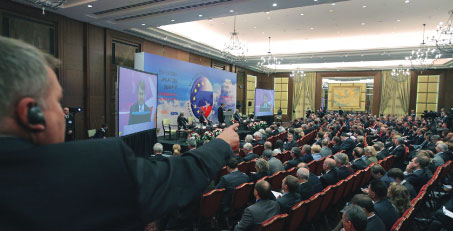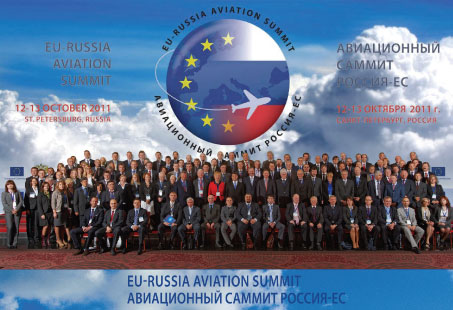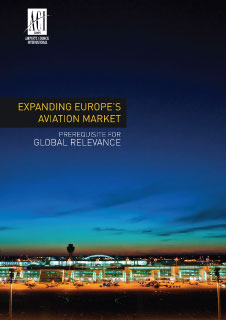
The EU-Russia Aviation Summit was jointly organised by the European Commission and the Russian Ministry of Transport and took place in St Petersburg on 12 and 13 October. Naturally, the aim was to enhance political, technical and industrial cooperation in the aviation industry and review the possibilities for aviation liberalisation between Russia and the EU.
The EU-Russia Aviation Summit was jointly organised by the European Commission and the Russian Ministry of Transport and took place in St Petersburg on 12 and 13 October. Naturally, the aim was to enhance political, technical and industrial cooperation in the aviation industry and review the possibilities for aviation liberalisation between Russia and the EU. Seasoned readers of ACI EUROPE’s monthly airport traffic reports know all about the extraordinary traffic growth that is taking place at Russia’s primary airports. Air transport between the EU and Russia has grown significantly over the last five years (+45%!). Growth in the Russian market for 2010 is particularly impressive, both for passengers (+22%) and for freight (+43%) and 2011 is set to be another very good year.
So, the neighbours are seeing more of each other. In fact, the EU is by far Russia’s largest international aviation market, with more than 40% of all Russian passenger traffic directed towards EU destinations. While Russia accounts for a smaller share of EU international air traffic to non-EU destinations now, (currently placing sixth in the EU aviation market league table), it still has an un-tapped potential for extremely dynamic growth subject to all existing regulatory and other “doing business” barriers being removed.
The EU-Russia Summit saw these figures mentioned a number of times, most particularly by the European delegation which included some 150 representatives from the European Commission and all key EU institutions in the field of aviation, as well as airlines, airports, aerospace industries, service providers and national governments.
In total, around 300 delegates attended the summit. The main issues addressed included: policy framework for the development of EU-Russia aviation relations; developments in the airline industry in Russia and the EU; safety and security – challenges and potential for cooperation; air traffic management, air traffic coordination and new technologies; environmental implications of air transport; business opportunities in the aeronautical industry; airport policy, infrastructure and investment.
High level representatives from both sides attended, including Siim Kallas, European Commission Vice-President Responsible for Transport; Cezary Grabarczyk, Minister of Infrastructure of Poland, representing the Presidency of the Council of the EU; and Igor Levitin, Minister for Transport of the Russian Federation. Kallas commented “The EU and Russia have so much to gain from closer cooperation in the aviation sector, both in relation to safety, industrial cooperation, air traffic management, sustainable growth and investment.”
‘Time to normalise’
Representing the airports, in both the EU and Russia, ACI EUROPE Director General Olivier Jankovec delivered a presentation on ‘Normalising air transport & unleashing the power of airports’. In a wide-ranging address, he expanded on the European experience of aviation liberalisation and the immense benefits it has brought and can bring, if further liberalisation occurs.
Reiterating the key points of ACI EUROPE’s recently released analysis paper ‘Expanding Europe’s Aviation Market: Prerequisite for Global Relevance’, the ACI EUROPE ‘Road Map’ calls for extending the European Common Aviation Area and reaching out to the EU’s main trading partners. This includes creating a Pan-European/Mediterranean Aviation Area, which is important to achieving the aim of completing the European Common Aviation Area of 58 countries and one billion inhabitants by 2020. Jankovec also stressed the need to kick start negotiations with the EU’s main trading partners in emerging markets – the BRIC (Brazil, Russia, India, China) and ASEAN (Association of South East Asian Nations) countries.
Highlighting the lack of progress of the EU-Russia Action Plan proposed in 2006, Jankovec grasped the nettle of the unresolved issues, namely the EU designation clause in Bilateral Air Services Agreements in force between Russia and individual EU Member States (such a clause needs to replace existing national clauses so as to allow any EU airlines to access the Russian market from any EU Member States) and the Siberian over-flight issue.
Another particularly pertinent point raised by ACI EUROPE was the difficulties in doing business in Russia. Citing the example of Russia recently adding visa restrictions on airline crews which do not leave the airport terminal, Jankovec denounced this practise, as it impacts on airport operations, causing significant delays. In the run-up to the Summit, ACI EUROPE formally raised this issue in a letter to Vice-President Kallas and also after the Summit in a letter to European Commissioner for Home Affairs, Cecilia Malmström. Since then, ACI EUROPE has received confirmation that the issue has been resolved within the EU-Russia negotiations for a new visa regime.
Laurent Muschel – member of the Cabinet of Cecilia Malmström, told Airport Business “Commissioner Malmström immediately raised the issue with the Russian authorities, at the highest level, and we are very pleased that it has been quickly resolved. In order to ensure that it does not happen again, it is important that the EU and the Russian Federation conclude an agreement on a legally binding reciprocal visa waiver for civilian air crew members. Such a visa waiver should be introduced into the revised EU-Russia Visa Facilitation Agreement, which is currently under negotiation.”
On the Community airline designation clause, there are also some signs of hope. The recent agreement with Finland sees Russia for the first time accept the principle of EU designation. The Siberian over-flight issue also leads on from the Bilateral Agreements. They force EU carriers to sign commercial agreements with competitor Aeroflot, which then dictates what EU airlines have to pay for overflying Siberia to Far East destinations – currently around €320 million a year. Russia is the only country in the world where such over-flights payments have to be made. As Jankovec put it in his presentation “It is high time to normalise aviation relations between the EU and Russia!”
While the Russian side reiterated that the Siberian over-flight payment would stop upon Russia’s accession to the WTO, it remains to be seen whether that commitment will be translated into action now that such accession has been formalised.
Air service agreements
Offering an airline perspective on the EU-Russia aviation market, Prof. Dr. Regula Dettling-Ott, Vice President EU-Affairs, Lufthansa, who also attended the Summit, explained that for the Lufthansa Group, the ties with Russia are of utmost importance. It has served the Russian market for 39 years. Lufthansa itself operates 147 weekly flights to eight Russian destinations, while, in total, the airlines within the Lufthansa Group operate 235 weekly flights to 10 Russian destinations. In 2010, the Lufthansa Group carried two million passengers between the EU and Russia. Cargo traffic is also important – Lufthansa flies to eight destinations, carrying 5,700 tonnes of cargo to Russia and 2,300 tonnes from Russia. “From the point of view of Lufthansa, Russia is a natural partner for Europe. Business ties and tourism between the two have increased and will further grow in the future. Russian infrastructure has gained admiringly both in terms of quantity and quality. This will allow the industry to grow further, both for Russian and foreign carriers,” said Dettling-Ott. “Lufthansa welcomes the fact that Russian authorities have agreed to find a new basis for air service agreements and to negotiate a solution for the Russian over-flight issue. In order to maintain the competitiveness of European and Russian aviation in a fiercely competitive global industry, such improvements are essential, as for both LH passenger airlines and LH-Cargo, Russia is an important partner to operate flights to Asia.”

In total, around 300 delegates attended the summit. The main issues addressed included: policy framework for the development of EU-Russia aviation relations; developments in the airline industry in Russia and the EU; safety and security – challenges and potential for cooperation; air traffic management, air traffic coordination and new technologies; environmental implications of air transport; business opportunities in the aeronautical industry; airport policy, infrastructure and investment.
Niky Terzakis, Managing Director, TNT Airways, meanwhile, provided a market outlook for EU-Russia cargo traffic. He explained that world air cargo traffic will triple over the next 20 years, and forecast that cargo tonnage carried between Europe and the CIS would grow at an average annual rate of 5% between 2009 and 2029, while in the opposite direction, between the CIS and Europe, it would grow by 6.5% per year. Looking at the challenges facing the industry, Terzakis said: “Service levels are compromised due to operational differences driven by lack of liberalisation and regulatory convergence. This presents us the opportunity to evolve the global regulatory model so that, as an industry, we can continue to meet demanding customer expectations.”

Reiterating the key points of ACI EUROPE’s recently released analysis paper ‘Expanding Europe’s Aviation Market: Prerequisite for Global Relevance’, the ACI EUROPE ‘Road Map’ calls for extending the European Common Aviation Area and reaching out to the EU’s main trading partners.
Russia undoubtedly needs investment for the much-needed modernisation of its airport infrastructure. Underlining the economic benefits liberalisation could bring, Dr. Yiannis Paraschis, CEO, Athens International Airport explained that the airport is an example of a successful public-private partnership initiative, which has resulted in AIA becoming an engine of economic development. “A PPP project, as shown in the Athens case, improves the quality of service level, creates value for shareholders and acts as a catalyst to economic development,” he commented.
An Airport City has been developed around AIA, with a wide socio-economic impact. Paraschis explained that it is the largest engine for economic growth and job creation in Greece, representing 2.14% of Greek GDP. The airport sustains 63,000 jobs on a local, regional and national level. There is every indication that Russia could become the next case study for such success.
Paraschis added: “The business opportunities that would stem for airports both in Russia and Western Europe from a closer and liberal integration of the EU-Russia aviation market would be significant. The Summit did not really deliver the expected commitments from the Russian side to address a range of pending issues or commit to such an integration. However, it has certainly helped improve understanding between both sides and the very strong ACI EUROPE position expressed at the Summit has clearly stressed the fact that the current standstill is holding back not only aviation but also trade and economic development between Russia and the EU.”
Regulatory framework
Matthew Baldwin, Director – Air Transport, European Commission, addressed the session on aviation security. He emphasised the need for robust aviation security systems for mutual recognition. “The EU’s regulatory framework for aviation security is based on ICAO Standards and has been designed in a way that allows appropriate action to be taken to address vulnerabilities as they manifest themselves and to tackle threats as they evolve,” explained Baldwin.
The creation of a One Stop Security area in the EU is one of the main benefits that a system based on common aviation security rules can deliver. It means that re-screening of passengers, baggage and cargo is not necessary on transferring at an airport by virtue of the security controls having been applied at the airport of origin and the integrity of the screened passengers, baggage and cargo being protected since. “The possibility not to re-screen transfer passengers travelling within the EU permits a more efficient use of limited resources and facilitates the flow of passengers, baggage and cargo. It is smart security,” commented Baldwin. “What’s more, the application of One Stop Security is not limited to the external borders of the EU. The EU framework permits the equivalency of security measures applied by non-EU countries to be recognised and, to-date, One Stop Security expands to Iceland, Norway and Switzerland. Outside Europe, One Stop Security arrangements have been concluded with the United States for passengers arriving on flights from America into Europe.”
Visible progress
The European Commission considers the Summit to have been a success, as it provided a forum to discuss important issues such as the legal conformity of bilateral air transport agreements, Siberian over-flight charges and sustainable air transport, as well as cooperation in air traffic management and aviation safety and security. There was consensus regarding huge potential benefits for both sides of wider cooperation between the EU and Russia in the aviation sector. Philippe Burghelle-Vernet, Head of Internal Market, Air Transport Agreements & Multilateral Relations, European Commission, commented “As regards matters of special interest for the EU side, Russia accepted shortly before the Aviation Summit to change its bilateral agreement with one EU Member State to be in line with EU law (in particular including the EU carrier concept). It is expected, as Russia also announced at the Summit, that bilateral agreements with other EU Member States will, without delay, be adapted accordingly. Furthermore, a solution to the Siberian over-flights issue is expected now that Russia has become a Member of WTO.” If these promising signs and expectations deliver results thanks to the momentum gained from the Summit, they might indeed be viewed as ‘green shoots’ for proper liberalisation between the EU and Russia.







